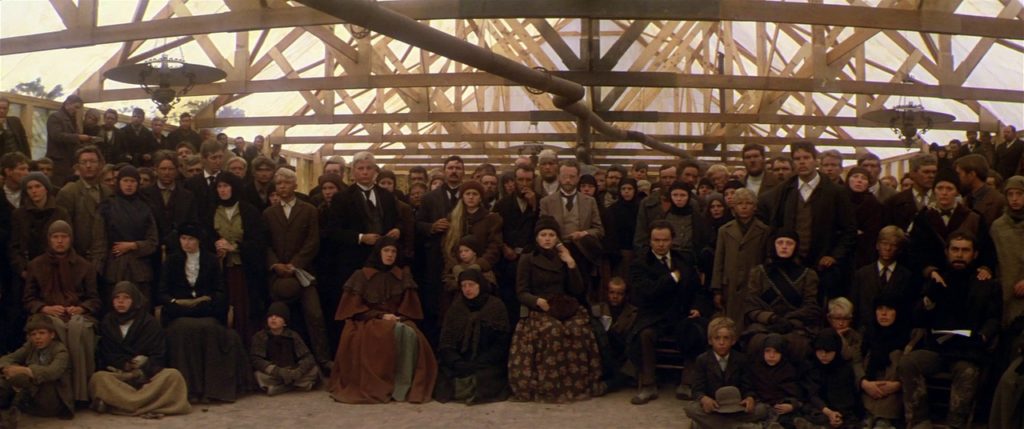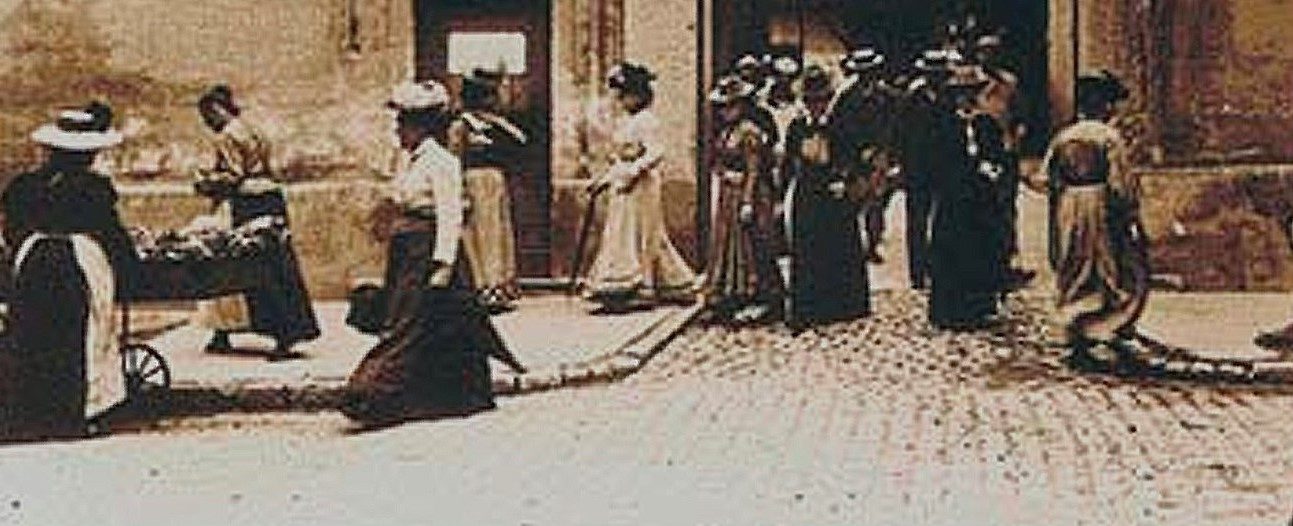United States, 1980
Directed by Michael Cimino
With Kris Kristofferson (James Averill), Christopher Walken (Nathan Champion), Isabelle Huppert (Ella Watson), John Hurt (William C. Irvine), Jeff Bridges (John L. Bridges), Sam Waterston (Frank Canton)

Heaven’s Gate is the grandiloquent name of the vast ballroom adjoining the saloon of a muddy little town located in Johnson County, Wyoming. This is where people have fun on Sundays, especially by dancing with roller skates on and also where they gather when they have to argue about big issues. The saloon, whose proud owner, John L. Bridges, also lodges the sheriff, is a big building too, since beyond the bar and the dining room (rather devoted to cockfighting and fist fights than to feasts) there is a kind of warehouse that shelters countless immigrants.
For the entire county (and the lands beyond) is the chosen destination of new immigrants streaming from Eastern Europe. Whole families, who are generally poor, ill-equipped, and barely literate in English, trudge along roads or stand on the roofs of speeding trains to try their luck in the American West, which often means surviving the harsh conditions that nature and mankind have in store for them. This survival struggle could include trespassing pasture lands and stealing cattle. This prompts a powerful association of stockbreeders to form a militia aiming to get rid of the intruders – that is, in this case, murdering 125 people. The county is set to be the stage of a bloody clash of social wills.
This is a story from the West in the early 1890s – a real social war occurred in this corner of Wyoming at this time, but the screenplay alters some facts while keeping some characters. The Frontier has been officially reached, at least according to the Census Bureau, the Native Americans have been fully defeated, and Wyoming has just entered the Union, which is witnessing the last years of that transformative period called the Gilded Age (to quote Mark Twain and Charles Dudley Warner) and the first years of a record rise in immigration. Choosing to tell this incident with this context in mind is a deliberate move that puts this western movie firmly apart from the genre’s productions (although George Stevens’ western “Shane” indirectly touched the topic in 1953). After studying how a working-class community from a small American industrial town was impacted by the Vietnam War in “The Deer Hunter” (1978), director Michael Cimino sets his eyes on another community of poor people and their doomed fight to settle down. Class issues and individuals’ failures define the film.
A trio of characters takes part in the events, bringing the audience right into the heat of the conflict and granting to it a sense of intimacy and personal tragedy. None is an immigrant, although her French accent and some lines suggest Ella Watson may be the daughter of immigrants. She is the Madame of the local bordello and the lover of two men. One is James Averill, the county sheriff who despises the stockbreeders, and the other is Nathan Champion, who is a security guard for those rich farmers and an assistant to Frank Canton, the political leader of the stockbreeders’ association and both the political and financial sponsor of the militia. These men are not poor and were educated in great colleges of the East coast. They have chosen to live in the West, for their own reasons, including money, and sometimes out of a better idea, like William C. Irvine, the brilliant Harvard companion of Averill who has become a clownish drunkard still trying to write poetry. Their background should have made them the best and brightest of their time but they are now men bitterly divided by interests and convictions, whose decisions relentlessly fuel a social conflict.
This conflict’s climax is a long pitched battle that takes up a good part of the movie. The graphic description of the violence, with its keen attention to gory and dreadful details, stuns and appalls while the conclusion dismays. The militiamen who have not been killed are arrested by the army, but Canton gets away with the disaster thanks to his friendship with the governor, while the settlers are ordered not to protest again and left to count their way too many dead and wounded. The massacre started with Champion’s vicious killing and ends later when Watson is shot dead as she is leaving the county with Averill. A happy ending has never been a possibility. Two poignant images encapsulate the depressing truth: a long shot focusing on Averill walking away from the battlefield and a close-up on a woman who has taken part in the battle and surveys the immensity of the human disaster before drawing her own conclusion, shooting herself in the head. Her dream, shared by the others, of living in a thriving and nice community has been shattered. The West has deliberately failed them.
The long Sunday afternoon spent in Heaven’s Gate dancing on roller skates is one the most famous sequences of the film, beautifully composed and seemingly too long. Cimino may be pushing the envelope but his intention is clearly to capture delightful, happy, aimless moments that bear witness to the strength of the bonds between those immigrants and their wish of standing together, despite their poverty and their cultural differences (between themselves or between them and their new country) which are expressed in German, Polish or Russian, tongues spoken as naturally as the local English and barely translated in the film – but what would have been the point of translating when the sense of community is so powerfully conveyed by a vision? Other, saddest, moments illustrate this collective feeling, from the shared urge to gamble on animals to the heartbreaking and passionate debate in the ballroom after Averill read the list of the 125 future victims. More cruelly, the ballroom sequence echoes another dancing party, shot in the prologue and featuring young men freshly graduated from Harvard (the same who would later fight over the Johnson County). Why the former would not get from their hard labor the same carefree life that the latter got out of their privileges? Greed and contempt can explain it, social attitudes starkly running counter to the values the United States boasts to embody.
Averill also incarnate troubling contradictions: he may be praised for his choice to put his riches aside and go west, but he entrusts his happiness to a whore and rebels against his own class. Truth is that Ella’s brothel feels like a haven where opposites can meet and bliss can be found – it is telling this is the first place in the town the militiamen attack – and that class sentiment can easily overcome personal virtues – Irvine’s grotesque end emphasizes that refusing to take sides when one has the means to do it for the best cannot be excused. The epilogue, occurring ten years later, shows Averill living the rich life he has always been entitled to; but he does not look happy at all; he could be missing a whole part of his life, which made sense to him, and brought him some satisfaction. Again, the Hollywood principle of the happy ending is dismissed. Only a bitter sense of regret would prevail.
“What one loves about life are the things that fade”: this was the tagline Cimino chose for “Heaven’s Gate”. The epilogue somehow justifies the idea and the film looks like a wistful depiction of a conquest that did not happen, shot most in the time in a soft, slightly dusty, warm light, with a soundtrack at times barely audible. This a melancholy film, even though it does have a sense of humor and tries to convey the formidable appetite for life most characters have. Cimino’s visual virtuosity imparts to all the sequences featuring groups, from the mayhem of a railway station to the gruesome battle scene, a breathtaking strength and moving reality, and the flick impress on this point.
Yet the narration is not quite as convincing as it was in “The Deer Hunter”, perhaps because his three main characters are not bound by a strong and endangered friendship, whose fate mirrors the challenges their native little society must rise to, but are in fact entangled in complicated love relationships that sometimes distract from the main story, whose tragic impact cannot be as deep-felt and existential for them as it is for the migrants around them, the prime targets of a capitalist wrath. The main characters feel somehow detached from the wider narrative and its poignancy, worsening the feeling the film is a bit unruly and too long.
It is too bad as this story deserved to be told, if only to remind the audience how hard a place the celebrated West was actually for a lot of immigrants (think of the scene showing a plow pulled by old women for lack of cattle) and the power of the moneyed interests over a still young nation (to say nothing about the 21st America) and as the intellectual and visual riches of this 216-minutes long film remain truly amazing.

